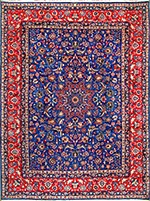Textiles Studies

Textile Research Works
Date of this Version
1976
Document Type
Thesis
Citation
New York University - Institute of Fine Arts. An MA Qualifying paper Submitted December 20, 1976, Professor T.F. Mathews.
Abstract
According to the Continuation of the chronicles of Theophanes the Bryas palace of Theophilus (829-842) was built in imitation of an Arab palace. The present inquiry into its Islamic source offers a new interpretation of the Bryas palace within the context of Middle Byzantine secular architecture and the development of court ceremonial. ::?revious studies have concentrated upon locating Bryas in efforts to determine the extent of Islamic impact on the architecture of Byzantium. The most recent attempt, put forth by Dr. Semavi Eyice, tentatively links the unexcavated ruins at KUyUkyal!, a suburb of Istanbul, with the literary description of Bryas palace. The plan of the ruins as they exist today indeed bears a similarity in general layout to throne room complexes in Abbasid and Umayyad palaces. can the prototype for Theophilus's palace be identified? The passage which describes Theophilus's palace explains that it was inspired by the embassy of John the Synkellos to the Abbasid court. Eistorical circumstances place the eobassy between AD 829 and 832, during the reign of Caliph al-Ma'mtin (AD 819-833). Textual sources indicate that he had three palaces in Baghdad. Kone of them has been identified, but the plans and general features may be suggested through an examination of available archaeological evidence for early Abbasid palaces, supplemented by literary references to the caliphal residences of al-Ma'mtrn, his father, H~rcrn al-Rashid, and his brothers, al-'Amin, and alMu'ta~ im, his predecessors and successors in Baghdad. A configuration of architectural forms is seen to emerge as characteristic, defined in terms of function designated by literary sources as serving in the audience and reception of the caliph. The origins of the architectural forms and the ceremonial traditions for the king's appearance are not of direct concern to a consideration of the Bryas palace; what is important, however, is that these features seem to be directly related to court ceremonial. Despite the fact that a source for the Bryas palace cannot at this point be documented archaeologically, it is clear that both the Byzantine palace and its Islamic prototype shared the characteristics of early Abbasid palace architecture. The similarity of the Byzantine ruins at KU9Ukyali to the architectural precepts identified in this study offers support to Eyice's conclusions. In view of the analysis presented by this research, it is suggested that the Bryas palace not only exemplifies the influence of Islam in Byzantium, but more importantly, its architectural forms reflect in a secular monument the tendency towards more rigid ceremonial which is already evident in the church architecture and liturgy of the Middle Byzantine period.
Included in
Art and Materials Conservation Commons, Art Practice Commons, Fiber, Textile, and Weaving Arts Commons, Indigenous Studies Commons, Museum Studies Commons


Comments
Copyright © 1976 Carol Bier.